
Did you buy a great, red, beautiful meat, leave it in the fridge and when you took it out to prepare it, was it whole or with some darkened or brown spots? Should I throw away brown meat? What determines the color is not necessarily the state of deterioration of the product, but rather the dynamics of a protein called myoglobin. The fact that parts are brown and others are red is related to the action of oxygen and not necessarily to the action of bacteria.
Meat color is defined by the type and breed of the animal, nutrition and ante-mortem treatment, stress during slaughter, post-mortem conservation and myoglobin status. Myoglobin is an oxygen transport protein and has the function of transporting and storing oxygen in muscle cells. In free-range animals, for example, muscle is more demanding and therefore has a greater amount of myoglobin, increasing the proportion of red fibers among white fibers.
The main determinant of color is the amount and chemical format of the myoglobin pigment. In muscles with high concentrations of this pigment, the color of the meat will be much more intense than in muscles with a lower concentration.
But how does meat change color?
The color of fresh meat is largely determined by the relative amount of the three forms of myoglobin, myoglobin in its reduced state or deoxymyoglobin (Mb) of a purple-red color, oxygenated myoglobin or oxymyoglobin (O²Mb) of a bright red color and oxidized myoglobin or metmyoglobin (MetMb ) brown in color. The reactions between the three forms of myoglobin are reversible and are in a state of dynamic equilibrium, with constant conversion between these forms of chemical composition.
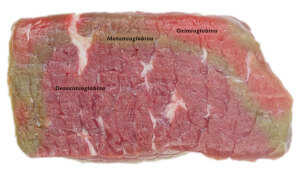
Vacuum-cooked meat, for example, may have a more purple color, as there is a low concentration of oxygen. When removed from the packaging and left for a few minutes in the presence of oxygen, the meat tends to become brighter red (oxymyoglobin). Even if the animal is already dead, the enzymes present in the muscle remain functional, and the enzymes that use oxygen to produce energy metabolize the oxygen present. During this process, the iron present is oxidized, transforming the meat from red to brown.


Environmental and hygienic factors can also affect these meat color dynamics. Lack of hygiene during slaughter increases the likelihood of bacterial growth, which has a stimulating effect on the formation of metmyoglobin (brown in color). High meat temperatures and the intensity and type of light are also factors that can harm the visual appeal.
Another interesting factor is the pH of the meat. Animals subjected to stressful situations during slaughter have a high pH, which alters the color. When the pH is high, the color of the meat is dark. This meat is called DFD, dark, firm and dry.
When meat is cooked, it irreversibly fixes the color of metmyoglobin, that is, brown.
How do I know whether or not I should consume meat?
Knowing that color does not determine the condition of the meat, use other resources, such as the time the product was stored, the expiration date printed on the packaging and the smell, smell the aroma of the product, your nose was developed exactly for that! A spoiled product has a bad smell and should be discarded, but a product without a strong smell can most likely be used.
-
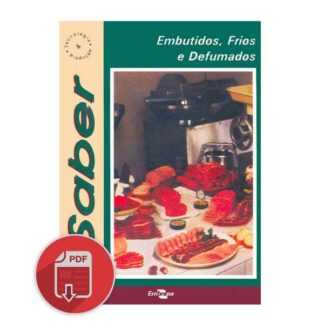 Embrapa Manual – Cold cuts, sausages and smoked meatsR$ 0,00
Embrapa Manual – Cold cuts, sausages and smoked meatsR$ 0,00 -
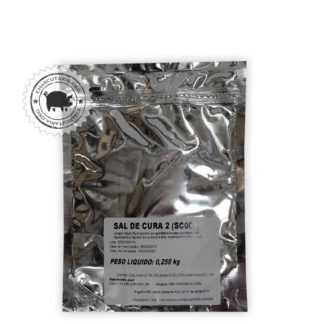 Curing salt 2R$ 8,00
Curing salt 2R$ 8,00 -
 Curing salt 1R$ 8,00
Curing salt 1R$ 8,00 -
 BRC Ingredients and Recipes BookR$ 0,00
BRC Ingredients and Recipes BookR$ 0,00 -
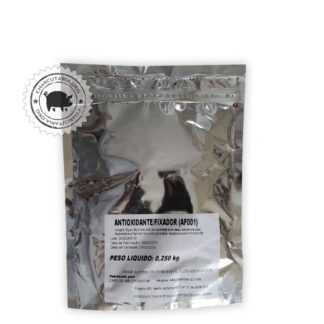 Fixative AntioxidantR$ 23,00
Fixative AntioxidantR$ 23,00 -
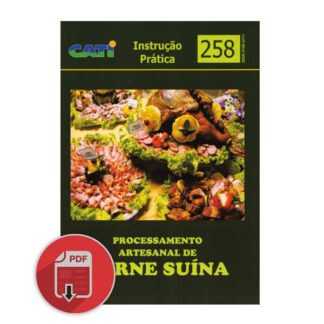 Artisanal Pork ProcessingR$ 0,00
Artisanal Pork ProcessingR$ 0,00 -
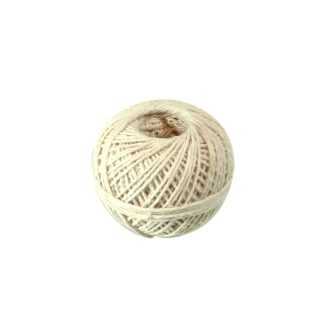 Culinary twineR$ 7,90
Culinary twineR$ 7,90 -
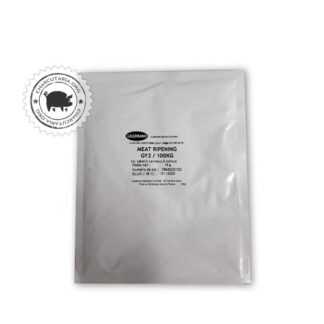 Starter CultureR$ 69,90
Starter CultureR$ 69,90



Top content. It helped a lot, thank you!
Good morning!
I bought the meat, it arrived, I chopped it and added curing salt and ibracor and when I roasted the meat it looked like dried meat (jerky). What to do?
I've never used this ibracor, I can't tell you.
I smoked a piece of ham and when I cut the meat inside it was greenish, what could this be? Thanks
Acho que é iridescência ou efeito arco-íris, que é um efeito da decomposição da luz, sendo visualizado como um brilho colorido. Ocorre pela refração da luz, a luz que incide sobre a carne é refletida de forma subdividida em diversas cores. A coloração mais comum da iridescência é a carne de coloração esverdeada brilhante, podendo também aparecer a coloração vermelho-alaranjado, azulada, rosa e amarelada. Se for esse o caso é um fenômeno físico de distorção de cor e a qualidade da carne não é afetada.
I would like to ask a question, I went to the market and saw in the meat refrigerator display some steaks approximately 4 to 5 cm thick, very red, beautiful, I bought a piece like that when I got home and went to cut the cubes for my wife to use as a pan, the meat was red around and dark inside the whole piece I didn't smell the smell but as I've heard that if the butcher gives the meat a water bath with bicarbonate it becomes beautiful again and odorless and in fact it didn't even smell like cut meat I went back there and I returned the meat, could you tell me if there really are bad people who do this, thank you
Because sometimes hamburgers fry, fry and look red as if they were raw, which happens.
Goodnight
I made the Salami and placed it at room temperature with the fan nearby for 48 hours and it had dark meat because this could have happened
It could have been the air from the fan
Hi George. The salami may have darkened quickly outside due to drying too quickly due to the direct incidence of dry air on the salami. Air circulation must be light and preferably with high humidity.
I made a sausage using ready-made seasoning that has nitrites and erythorbate. Frozen, it has a pinkish color, but when refrigerated it becomes darker but not pink or red. What can I fix, since I don't use dye. AND
Hi Tamires, try to pack the sausages better during refrigeration, using vacuum packaging or a thick plastic bag with as little air as possible. Oxygen changes the color of meat and is also a medium for fat oxidation.
Hello, I have a question, I have some meat here, which was seasoned with lemon, salt and oregano, it was in the fridge for about 4 days, it has a gray color and has small red areas, in the smell it does not have a strong smell only It has an acidic smell, when you feel it it is hard and there is no sign of slime at all, but I'm in doubt because of that color, can you help me?
Here's a photo!
If only the color is altered and the smell and viscosity are normal, then you can consume it. If in doubt, the photo looks perfect.
Thank you very much, I sincerely thank you for clarifying your doubts
Hello, I would like to ask a question, I make artisanal salami, I only use the curing room as a preservative. After curing, I vacuum pack it, but after 10 days in the vacuum, the salami starts to turn brown and each day it becomes lighter brown. What should I do or what product or chemistry should I use to maintain the quality of my salami?
remembering that I want to avoid nitrates..
Hello. Meat has a dynamic color, read the post Understand the color of meat. One of the functions of curing salt is to fix the reddish color. I suggest you test making a recipe using curing salt and an antioxidant/fixer to see if this change continues to occur. If this is the case, it is possible to carry out a “natural cure” using plant extracts that naturally contain nitrate.
How long does salami spend curing and how much weight does it lose?
I bought some corned beef, it was brownish red in color. When frying, it showed a red color. I was worried because, no matter how much I fried it, it would still be red, despite having the flavor of sun-dried meat. Explain to me what could have happened. Thanks!
Hello Alessandra. The same happened with the sun-dried meat I used today. I was very curious to know the answer to what happened to yours and my flesh. Were you able to get any answers?
Hello,
I decided to try the aging process of 2 tbone steaks measuring about 3cm each. I placed it in a container away from the bottom (grill) and covered it with film. I kept it at 4 degrees for 7 days. When removing the container there were droplets on the film. There is almost no liquid at the bottom of the container. Anyway, the meat was darker, slightly brown, the smell was stronger than normal but it didn't seem like it was spoiled. What worried me was that the surface of all the steaks became slimy. I scraped off this slimy surface with a knife and below it was reddish and perfect. Did the steaks spoil? Is using aluminum foil to cover better than plastic wrap? 4 degrees is too high? My refrigerator is electronic and very rarely opened.
Hi Emmanuel, from what you described, the meat appears to be good, but I have no experience in maturation/aging, so I wouldn't know how to say that. As far as I know, the temperature is correct, but there are processes with ventilation and humidity also controlled, where the meat is exposed, not covered. Others are in a vacuum where only the temperature needs to be controlled. Depending on the process, you may need to cut/clean the surface of the meat after a few days. Take a look at the ones below, they might help.
http://www.beefpoint.com.br/aprenda-como-preparar-carne-maturada-a-seco-dry-aged-em-sua-casa/
https://www.usmef.org/guidelines-for-u-s-dry-aged-beef-for-international-markets/
For maturation, it is more advisable to use a large piece as you will lose a lot of dry or vacuum maturation, the vacuum is 15 to present superior softness, dry maturation is 30 days, then you need a refrigerator with controlled humidity around 70 to 80% temperature is ideal…
Hello, what is the process to oxidize meat without losing quality? I ask because I work with ground beef marinated in lemon, overnight, but sometimes the meat remains red, after the marinating process the meat is placed in the oven at 280º, but does not lose its red color. Some customers complain that the meat is raw. Thanks.
Hello, please ask me a question. I bought a piece of rump heart when it expired, it doesn't have a bad smell, it's not sticky but there are very dark pieces inside the piece (like clotted blood) should I consume this meat?
Márcia, this meat is probably not of good origin. I believe you can consume it, but look for another supplier.
Good morning. After desalting a piece of beef jerky, I checked the entire edge for a sparkling greenish color. What can it be? Color of the internal part and characteristic odor.
I think it's iridescence or the rainbow effect, which is an effect of the decomposition of light, being visualized as a colorful glow. It occurs due to the refraction of light, the light that falls on the meat is reflected in a subdivided way into different colors. The most common coloration of iridescence is bright greenish flesh, and red-orange, bluish, pink and yellowish coloration may also appear. If this is the case, it is a physical phenomenon of color distortion and the quality of the meat is not affected. Below is a photo of the iridescence phenomenon, leaving the meat with shiny metallic tones.
Hello my name is Alexandre I have a counter where the meat is burning I want to know what the ideal temperature is
Alexandre, the ideal is to keep the meat at 4ºC or less. It may be burning due to dryness, try humidifying the inside with containers of water. If it is not hanging, you can cover the meat with plastic wrap, this will inhibit the transfer of moisture between the meat and the dry environment. I hope I helped, hugs!
I bought a soft cushion, when I went to make it, a blue foam appeared, is it ok?
And when raw meat is normal and then cooked, does it have black spots? 2 months after expiration! But beef can't be consumed up to 3 months later?
It's a beef rib, it packs a punch and smells absolutely normal!
Raw beef that is 2 or 3 months out of date? If in doubt I would throw it away!
I bought salted sirloin to season the beans. I kept it frozen for about three months. I noticed that the meat doesn't freeze like the others, I deduced that because it was salty there was this difference. I went to use it and it was all greenish in color. Can I consume it normally? Thanks
Hello, good evening, I bought steak on a roll and when I got home I noticed a faded color, what should I do??
Assess whether the establishment you purchased it from is trustworthy, check the expiration date again, smell it, touch it to see if it's not gooey... if everything seems ok, you can consume it, the greenish color, as shown in the post, is not the only factor determining the state of meat contamination. If you are still in doubt, discard it, as it is always better to prevent it.
Hello! I bought a beef fillet but the appearance left me in doubt, it is very white and has a very sour smell as if they had used a lot of vinegar to wash it. I didn't want to eat it because I believe that all the proteins in the meat were gone and all that was left was the dough because it looked rubbery. I hate spoiling food, but I'm afraid of eating meat that's already rotten.
Bianca, better throw it away, the white could be a microorganism or a lot of sebum. Sour is a problem, as many butchers throw chemicals on meat to give it more shelf life, leave it on the counter, it's not sold there, wash it with vinegar or even bleach, rinse it and put it back on the counter or in those Styrofoam trays with a new date. Buy from well-known places or from certified refrigerator vacuum cleaners (SIF, SIE or SIM seal).
Good evening, my name is Rodrigo I have a question I made some salamis I used curing salt 2 table salt and seasonings but I didn't use the fungus to inoculate and I also didn't use the fermentation culture in the dough I only added dry wine, I'm drying them in one of those boxes with a screen suitable for sausages and now after 7 days hanging there some salamis are getting the upper part with darker meat, is it spoiled or is this normal and is curing salamis like this in these boxes at room temperature ok?
It is important to control the temperature and humidity so that the product matures correctly. The ideal is between 14 and 18 degrees, with 80% humidity. This darkening could be a lot of things, there's no way to know. Is your region hot? damp? Most bacteria proliferate above 18 degrees, if it stays between 25-35 degrees it is very risky. Just like culture, wine acidifies and helps with preservation. Curing salt also helps, but I think it's too risky to leave it at room temperature.
Thanks for the tip!
In the afternoon I bought some beautiful rump steaks, packed in a Styrofoam tray. On the same day at night, I went to prepare them, and when I removed the upper steak, I noticed that the lower part that was in contact with the lower steak was greenish, as was the upper part of the lower steak; the same happened with the third steak compared to the second. The odor was normal, with the color of the parts in contact being the only strange thing. This is normal? Can it be consumed?
Apparently normal, this occurred due to the difference between the covered area and the area exposed to oxygen,
I bought some good looking meat but it came with blood clots. What does that mean? Meat with blood clot
Hello Neusa.
Observing small amounts of clots in the meat can be common and are generally not indicative of any change in the process of obtaining the product.
The fact may have occurred because there is still a small amount of clotted blood in vessels present in the meat and during cutting this clot could leak.
I loved the material, very enlightening.
Hello,
Please, I cooked dried meat (I did the process at home, under refrigeration, and when I shredded it, the parts that contained sinews or fat that melted during cooking were dark and the sinews after cooking had greenish tones... Could it be that it has gone bad or is there some process that explains?
Very grateful!
It's normal, some people can see a greenish fluorescent color. If you look at it from different angles, you can see that it changes color or the color disappears. If it doesn't happen, it's because it's damaged.
Hi guys, I bought 2 packages of corned beef, both with the same date, which expire on 05/19/2016. 1 package had a different smell than the other, but it's not the common smell of spoiled meat, it's not that strong! Can anyone explain to me what it could be? I don't know much about corned beef. Thank you very much in advance…
Is the sun-dried meat you are referring to from the northeast less dry and less salty than beef jerky? The variation is great as this production is generally rustic and does not follow many standards. Is it artisanal or industrial, does it have a SIF, SIE, SIM or SISBI seal?
Hello! I bought ground duck meat, it looked great with no bad smell, very red. I went to make battered and fried steaks, it looked red after frying, it didn't taste bad but I found it strange, I've always made it and it turned out great, what explains that?
I have the same question and there is no answer here… 🙁
Very enlightening! I was always in doubt whether the meat with a brown tone would be good, despite it being expired and without a strong odor. Now I am more confident with the decision criteria. Thanks
Good morning, I read in one of your publications about a product that when used, we can reduce the use of curing salt, what is the name?
I don't know how to reduce the amount of curing salt. Perhaps it is the ascorbic acid that reduces the formation of nitrosamines (a possibly carcinogenic villain generated by nitrite in the stomach).